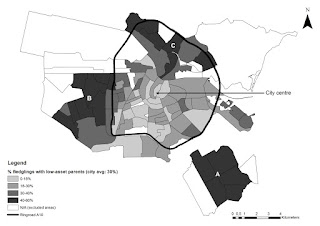The Spatial Dimension of US House Prices
Katharina Pijnenburg, DIW Berlin
House prices spill over from
one region to another region. This is analysed in the literature and is known
as the ripple effect. But when I plotted quarterly house price data over time
for 319 US metropolitan statistical areas, I noticed that these spillovers do
not seem to be uniform across space and time. When looking at this graph it is
easy to see that in coastal regions rising house prices are transmitted to
neighbouring regions, while this does not happen inland.
Figure 1 - Annual
growth rate of regional house prices
I wondered where such a
result could come from and discovered in the behavioural literature the
disposition effect (Shefrin
and Statman, 1985), which reflects the phenomenon in financial markets that
investors sell their winning stocks too soon and hold their losing stocks too
long. The disposition effect also holds for the real estate market and implies
a market slowdown in times of decreasing house prices. Sellers confronting losses
are likely to set higher list prices. If buyers are unwilling to pay these
prices, houses stay on the market for a longer time. Homeowners could decrease
list prices, but instead delay selling in order to avoid nominal losses. This
behaviour reduces the transaction volume in the housing market and,
consequently, limits house price spill overs.
The key question arises as
to why do sellers set higher list prices and delay selling when they are
confronted with a loss.
In the behavioural economics
literature there are several concepts that may provide an explanation. The
concept of mental accounting, for example, means that individuals group
elements of their consumption and expenditures in mental accounts. They follow
their personal rules in managing those accounts. When homeowners hold on to their
losing asset, it is because in their mental account the loss is only booked
when the asset is sold. This means that, if migration, as a driving force of
house price spill overs, slows down due to loss aversion, spill overs should
also decrease. Another potentially relevant concept is cognitive dissonance,
the mental conflict that occurs when people find evidence that their beliefs
are not true. People experiencing cognitive dissonance try to trivialize or
avoid the new information, developing explanations as to why their current
beliefs or assumptions should not be revised. For the housing market this would
mean that homeowners avoid the information of declining house prices or try to
find explanations as to why this decline does not apply to their home. Thus,
they will not reduce their asking price even when confronted with falling house
prices in the region. This behaviour should be reflected in smaller house price
spillovers.
My analysis shows that it is
not appropriate to assume that house price spill overs are uniform across space
and time. In times of declining house prices spill overs are much lower than
what linear estimations suggest. This result can very well be explained by
taking into account seller’s behaviour.


